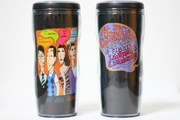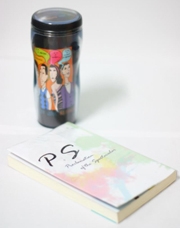Academic Papers 學術性文章
Research Report
An Enchanting Uncertainty: Androgyny Fashion
By Emile Lin 林政憲
Fashion is transformative. It is capable of creating an external image for a person to exude the desired characteristics or to fit in well with different occasions. For instance, the extravagant attire of Louis XIV was not only a representation of his status but a vivid expression of his authority. Specifically, the luxurious styling of Louis XIV tailors a compelling image for him to convince the masses of his royal power, and furthermore give him an aura of grandeur. The protagonist Eliza Doolittle in Pygmalion is yet another instance illustrating the transformative power of fashion. The ethereal gown she wears at the Embassy’s Ball transforms her from a normal flower girl into an elegant lady, which offers her an appropriate look to cater for the event and mesmerizes people with her beauty. To put it differently, fashion is a material power to “offer an image as a (deceptive) picture, almost as a dimension of mutation” to people (Loschek 155), and ultimately to allow them to undergo a metamorphosis.
Aware of the transformative essence of fashion, people thus take advantage of it to make fashion itself fashionable. That is to say, they start to extend the fashion-shaped image from one-dimensional to two-dimensional with an additional component: gender. In general, people dress themselves in accordance to the social expectation of gender traits. Therefore, clothes are actually a means of doing gender. However, the desire to trespass, so common in human nature, triggers some people to cross the borderline between male and female by experimenting with fashion. As a result, clothing no longer stands for a specific gender; rather, it encompasses both feminine and masculine attributes. To be more specific, two incompatible characteristics are shown simultaneously in a fashion image to not merely deemphasize the traditional gender-specific nature fashion carries but arouse a sense of ambiguity that mesmerizes others. Moreover, the incompatibility, according to Loschek, contributes to “an interface of fashion-art-gender crossing” (54) – that is, androgyny fashion, a trend with a charming ambiguity. To gain insight into the aesthetics of androgyny fashion, it is essential to both define the term and cross-reference it by understanding the concepts of its practitioners and appreciating the uniqueness of the icons embodying this trend.
—Complete version available in P。S magazine issue no.2
Research Paper
A Study on Instructors’ Characteristics and Pedagogical Style and Students’ Level of Motivation to Learn English
By Joey Hsu 許程勛
|
Table of Contents Abstract I. Introduction II. Literature Review III. Research Questions IV. Methods V. Findings and Discussion VI. Conclusion VII. Appendix A. Questionnaire B. References |
Abstract
This research attempts to determine whether Freshmen English instructors’ characteristics and pedagogical style have an influence on college students’ English learning motivation. The results of this research come from the perspectives of students who have taken Freshmen English and who are non-English majors at Fu Jen Catholic University (FJCU). This is a quantitative study that compares both motivated and less motivated learners’ preferences for their Freshmen English instructors’ characteristics and pedagogical style.
The results suggest that both kinds of learners share a similarity in their preferences for instructors’ characteristics, while they differed in their preferences for instructors’ pedagogical style. Fifty one questionnaires are administered through the method of snowball sampling, revealing that (a) almost half of the participants are motivated to take Freshmen English, while more than half are not; (b) both motivated and less motivated learners consider Freshmen English instructors’ characteristics and pedagogical style influential in their English learning; (c) the majority of both motivated and less motivated learners consider a pleasant classroom learning atmosphere and instructors’ sense of humor relatively critical; (d) the majority of motivated learners prefer a pedagogical style known as “cooperative learning” most, while the less motivated learners prefer a style where they “learn by discovery”; and (e) more than half of the motivated learners are satisfied with their Freshmen English instructors’ characteristics and pedagogical style, while more than half of the less motivated learners are not.
This research is worth conducting due to the risk of the gradual decline in English learning motivation by the majority of college students who are non-English majors. The outcome of this research can provide suggestions for instructors who teach Freshmen English to non-English majors at FJCU to help them effectively teach English at the college level.
Key words: instructors’ characteristics, pedagogical style, English learning motivation.



